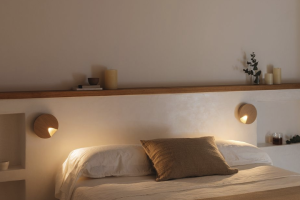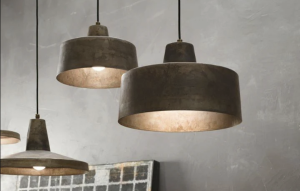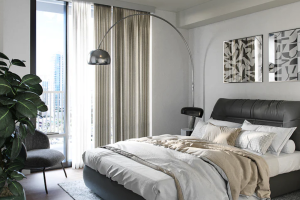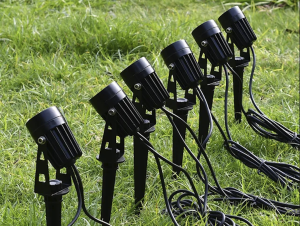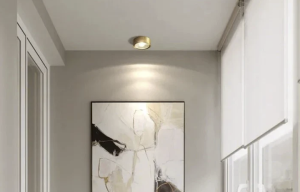Enhance Your Sleep Space with a Wall Lamp

Creating a relaxing sleep environment is essential for getting a good night’s rest. One often overlooked aspect of this environment is lighting. The right lighting can make a significant difference in the ambiance of your sleep space and contribute to a more peaceful and restful sleep. One way to achieve this is by incorporating a wall lamp into your bedroom decor. Wall lamps not only save space but also provide focused lighting that can create a cozy and inviting atmosphere in your bedroom.mergelighting
The Benefits of a Wall Lamp for Your Sleep Space
One of the primary benefits of using a wall lamp in your sleep space is that it saves valuable floor space. Unlike bedside lamps or floor lamps, wall lamps are mounted on the wall, freeing up space on your nightstand or floor. This can be especially beneficial if you have a small bedroom or limited space. Additionally, wall lamps provide focused lighting that can be directed exactly where you need it, such as for reading or working in bed.
Another advantage of using a wall lamp is that it can create a cozy and inviting atmosphere in your bedroom. The soft, warm glow emitted by a wall lamp can help create a relaxing ambiance that promotes sleep. Unlike harsh overhead lighting or bright bedside lamps, wall lamps provide a softer and more diffused light that is easier on the eyes and conducive to relaxation.
How to Choose the Perfect Wall Lamp for Your Bedroom
When choosing a wall lamp for your bedroom, there are several factors to consider. First, consider the size of the lamp and how it will fit into your space. Measure the area where you plan to install the lamp to ensure it will fit properly and not overwhelm the room. Additionally, consider the style of the lamp and how it will complement your bedroom decor. Choose a style that matches your personal taste and enhances the overall aesthetic of your sleep space.
Brightness is another important factor to consider when selecting a wall lamp. Think about the purpose of the lamp and how much light you will need. If you plan to use the lamp for reading or working in bed, you may want a brighter light. However, if you are looking for a lamp that creates a soft and relaxing ambiance, a dimmer light may be more suitable.
The Role of Lighting in Creating a Relaxing Sleep Environment
Creating a relaxing sleep environment is crucial for getting a good night’s sleep. The right lighting can play a significant role in achieving this environment. Harsh overhead lighting or bright bedside lamps can be stimulating and disrupt your body’s natural sleep-wake cycle. On the other hand, soft and diffused lighting, such as that provided by a wall lamp, can promote relaxation and help prepare your body for sleep.
Lighting can also affect your sleep quality by influencing your body’s production of melatonin, a hormone that regulates sleep. Bright or blue light, such as that emitted by electronic devices or certain types of lighting, can suppress melatonin production and make it more difficult to fall asleep. In contrast, warm and dim lighting, like that provided by a wall lamp, can help stimulate melatonin production and promote better sleep.
Wall Lamps vs. Bedside Lamps: Which is Better for Your Sleep Space?
When it comes to lighting options for your sleep space, wall lamps and bedside lamps are two popular choices. Both options have their advantages and disadvantages.
Wall lamps save space by being mounted on the wall, freeing up valuable surface area on your nightstand or floor. They also provide focused lighting that can be directed exactly where you need it. This can be beneficial if you enjoy reading or working in bed, as you can easily adjust the position of the lamp to suit your needs.
Bedside lamps, on the other hand, offer more flexibility in terms of placement. They can be easily moved around and placed wherever you need them. Additionally, bedside lamps often come in a wider variety of styles and designs, allowing you to find one that perfectly complements your bedroom decor.
Ultimately, the choice between a wall lamp and a bedside lamp depends on your personal preferences and the specific needs of your sleep space. Consider factors such as space availability, lighting requirements, and aesthetic preferences when making your decision.
The Best Wall Lamp Styles for a Cozy and Inviting Bedroom

When it comes to choosing a wall lamp for your bedroom, there are numerous styles to choose from. The style you choose can greatly impact the overall mood and ambiance of your sleep space.
One popular style for a cozy and inviting bedroom is the industrial style. Industrial wall lamps often feature metal finishes and exposed bulbs, giving them a rustic and vintage look. These lamps can add a touch of character and warmth to your bedroom decor.
Another style that works well in a cozy bedroom is the farmhouse style. Farmhouse wall lamps typically have a more rustic and country-inspired design. They often feature distressed finishes, wooden accents, and soft, warm lighting. These lamps can create a charming and inviting atmosphere in your sleep space.
For a more modern and minimalist look, consider choosing a sleek and streamlined wall lamp. These lamps often have clean lines and simple designs, making them perfect for contemporary bedrooms. They can add a touch of sophistication and elegance to your sleep space.
How to Install a Wall Lamp in Your Sleep Space
Installing a wall lamp in your sleep space is relatively straightforward. Here are some step-by-step instructions to help you get started:
1. Choose the location: Determine where you want to install the wall lamp. Consider factors such as the height of the lamp, the position of the electrical outlet, and any other furniture or fixtures that may be in the way.
2. Turn off the power: Before beginning any electrical work, turn off the power to the area where you will be installing the lamp. Locate the circuit breaker or fuse box and switch off the corresponding circuit.
3. Mark the location: Use a pencil to mark the location where you will be installing the wall lamp. Use a level to ensure that the mark is straight and aligned with your desired position.
4. Install the mounting bracket: Attach the mounting bracket to the wall using screws and a screwdriver. Make sure the bracket is securely fastened and level.
5. Connect the wires: Carefully connect the wires from the wall lamp to the corresponding wires in the electrical box. Follow the manufacturer’s instructions for proper wiring.
6. Attach the lamp: Once the wires are connected, attach the wall lamp to the mounting bracket using screws or other provided hardware. Make sure the lamp is securely attached and level.
7. Turn on the power: After double-checking all connections, turn on the power to the area where you installed the wall lamp. Test the lamp to ensure it is functioning properly.
The Importance of Dimmer Switches for Your Wall Lamp
Adding a dimmer switch to your wall lamp can greatly enhance its functionality and versatility. Dimmer switches allow you to adjust the brightness of your lamp, giving you more control over the lighting in your sleep space.
One of the main benefits of using a dimmer switch is that it allows you to create different moods and atmospheres in your bedroom. You can easily adjust the brightness of your wall lamp depending on your needs and preferences. For example, you can dim the light for a relaxing evening reading session or increase the brightness for tasks that require more light.
Dimmer switches also help promote better sleep by allowing you to create a more soothing and calming environment in your bedroom. By reducing the brightness of your wall lamp, you can create a softer and more diffused light that is easier on the eyes and conducive to relaxation.
Wall Lamp Placement Tips for Optimal Sleep and Comfort
The placement of your wall lamp can greatly impact its functionality and effectiveness in your sleep space. Here are some tips for optimal wall lamp placement:
1. Consider the purpose: Think about how you plan to use the wall lamp. If you will be using it for reading or working in bed, place it near your headboard at a height that allows for easy access and optimal lighting.
2. Avoid glare: Position the wall lamp in a way that avoids direct glare. Direct glare can be uncomfortable and disruptive to sleep. Angle the lamp downward or use a shade to diffuse the light.
3. Balance the lighting: If you have multiple light sources in your bedroom, such as overhead lighting or bedside lamps, make sure they are balanced with the wall lamp. The goal is to create a harmonious and well-lit sleep space.
4. Consider symmetry: If you have two wall lamps, consider placing them symmetrically on either side of the bed. This can create a balanced and visually pleasing look.
5. Test different positions: Don’t be afraid to experiment with different placements before settling on the final position for your wall lamp. Move it around and see how it affects the overall lighting and ambiance of your sleep space.
How to Incorporate Wall Lamps into Your Bedroom Decor
Incorporating wall lamps into your bedroom decor is a great way to enhance the overall aesthetic of your sleep space. Here are some tips for seamlessly integrating wall lamps into your bedroom decor:
1. Choose complementary styles: Select wall lamps that complement the existing style and theme of your bedroom decor. Consider factors such as color, material, and design when making your choice.
2. Create a focal point: Use wall lamps to create a focal point in your bedroom. Install them above a piece of artwork, a mirror, or a headboard to draw attention and add visual interest.
3. Coordinate with other lighting fixtures: If you have other lighting fixtures in your bedroom, such as overhead lights or bedside lamps, make sure the wall lamps coordinate with them. Choose similar finishes or styles to create a cohesive look.
4. Use wall lamps as accent lighting: Wall lamps can be used as accent lighting to highlight specific areas or features in your bedroom. Install them near a bookshelf, a dressing table, or a cozy reading nook to add warmth and depth to the space.
5. Consider the size and scale: When choosing wall lamps, consider the size and scale of your bedroom. Larger rooms may require larger wall lamps to create a balanced look, while smaller rooms may benefit from smaller and more delicate designs.
Wall Lamps for Better Sleep: A Cost-Effective Solution for Your Sleep Space
Incorporating a wall lamp into your sleep space is not only beneficial for creating a relaxing environment but also a cost-effective solution. Wall lamps are often more affordable than other lighting options, such as chandeliers or floor lamps. They also require less maintenance and are generally more energy-efficient.
Additionally, wall lamps can help save on electricity costs by providing focused lighting exactly where you need it. Unlike overhead lighting that illuminates the entire room, wall lamps allow you to direct the light where it is needed most, reducing unnecessary energy consumption.
In conclusion, incorporating a wall lamp into your sleep space can have numerous benefits. From saving space to creating a cozy and inviting atmosphere, wall lamps offer a practical and stylish lighting solution for your bedroom. By considering factors such as size, style, and brightness, you can choose the perfect wall lamp that complements your bedroom decor and enhances your sleep environment. So why not consider adding a wall lamp to your bedroom decor and enjoy the many benefits it has to offer?

